2024..01.01.39
Files > Conference Series > 2024 > Chimboazo ild pagina nueva
Isophreatic curves of groundwater wells in the upper zone of Cerro de Hula, Santa Ana, Francisco Morazán
Kelly Almendares-Rivera 1,2 *, Tania Peña-Paz 3
1 Master's in Water Resources with a Focus on Hydrogeology/ Science’s Faculty, National Autonomous University of Honduras (UNAH), Tegucigalpa, Honduras, 11101, [email protected].
2 Water Resources Unit, Honduran Institute of Earth Sciences (IHCIT) / National Autonomous University of Honduras (UNAH), Tegucigalpa, Honduras, 11101. [email protected].
3 Experimental and Innovation Center for Water Resources (CEIRH-IHCIT), Master's in Water Resources Coordination - National Autonomous University of Honduras (UNAH), Tegucigalpa, Honduras, 11101; [email protected].
* Correspondence: [email protected]; Tel.: (Almendares-Rivera, K.)
Available from. http://dx.doi.org/10.21931/RB/2024.09.01.39
ABSTRACT
The research is part of a master's research thesis, the aim of which is the generation of groundwater well curves in Cerro de Hula, located south of the capital of Honduras, which serves as a baseline to understand the movement of groundwater flow in the area preliminarily. To achieve this, groundwater level surveys were carried out in the field in April 2022 (dry season), which were analyzed, processed, and interpolated using the Kriging method in ArcGis software. The main findings show the survey of 21 groundwater extraction points, belonging to shallow and deep wells that supply around 2900 people in the area, and that the preliminary water movement according to the isophreatic curves corresponds to a radial flow, with curves ranging from 5 m deep of the water table remaining in the western part of the area (highest part), and moving downwards to the 100 m deep curves (eastern region). It is conclusive to mention that this is a preliminary tool for managing the area's underground water resources.
Keywords: groundwater, water table, isophreatic curves, radial flow.
INTRODUCTION
The study area is located south of the capital of Honduras, the city of Tegucigalpa, specifically in Cerro de Hula, between the municipalities of Santa Ana, San Buenaventura, and Ojojona, belonging to the department of Francisco Morazán, with an area of 18.7 km2.
Within the study area are two of the main villages of the municipality of Santa Ana, El Limón and La Bodega (see Figure 1), identifying around 11 communities (between villages and hamlets) with an approximate population of 3,287 people, living in 727 homes1.
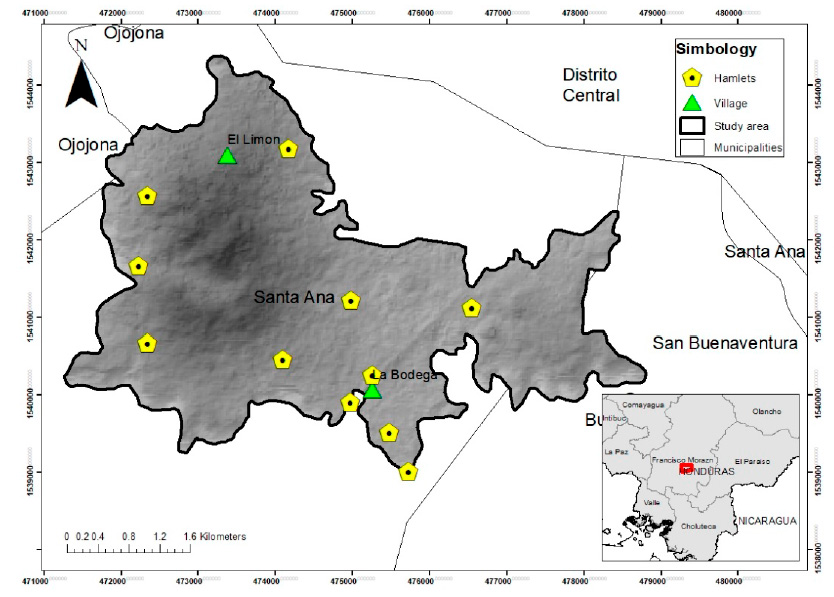
Figure 1: Location map of the study area and main villages and hamlets.
Land use in the study area is dominated by pastures and crops, broadleaf forest and deciduous secondary vegetation, with 35.4%, 35.3%, and 23%, respectively (see Figure 2 and Table 1). It is essential to highlight that the abundance of pastures and crops is consistent with the area's predominant economic activities (agriculture and livestock) and that, between the urban area and bare land, they add up to 1.2%2.
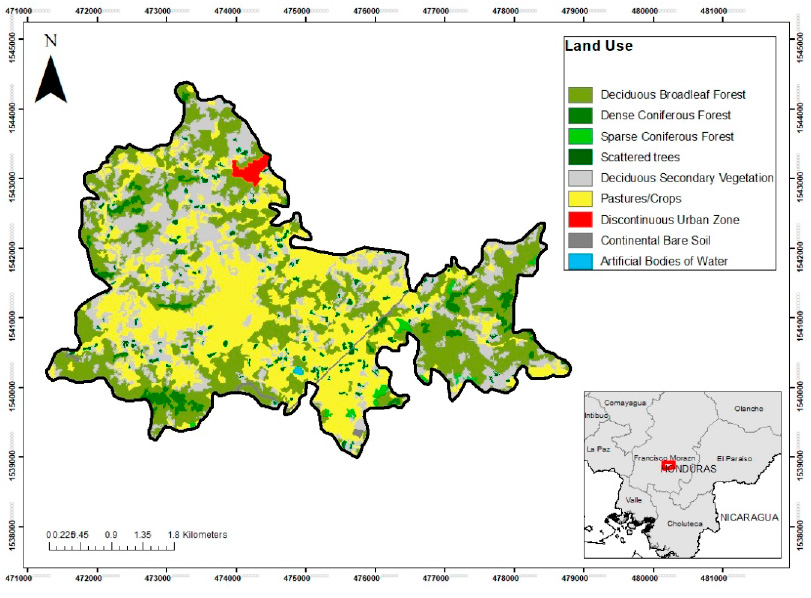
Figure 2: Land use map in the study area.
The distribution of land use by percentage is shown in the following table:
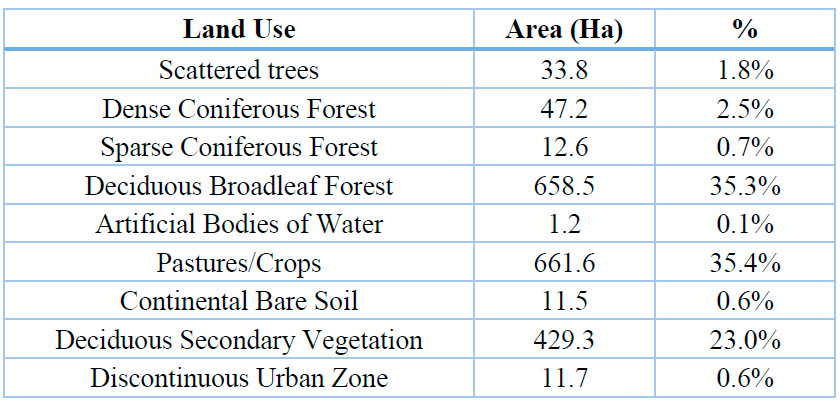
Table 1: Land uses study area.
The climate is characterized by relatively high rainfall, with average annual precipitation between 1197 mm and minimum values of 1126 mm, and average annual temperatures between 22.6°C, the maximum value, and 21.5°C, the lowest value3.
Morphologically, this study area has elevations exceeding 1460 meters above sea level (masl), reaching its highest part in Cerro de Hula with approximately 1700 masl (see Figure 3), considered one of the central hills in the area's municipalities. This hill has been considered in geological studies as a water shield volcano, where the activity has now ceased, and according to the presence of rocks, it is regarded as a fractured basaltic dome located in the western part of the work area, where the basaltic lava flows that have given it this table-like morphology4 originated. Therefore, it has a rugged relief due to fractures, faults, and other geological structures. Moreover, as Ruiz (2015) indicates, prior to the volcanic event, rocks' high erosion and sedimentation rates led to numerous fluvial terraces, which is evident today4.
Among the geological formations present in the study area are the Quaternary basalts, a series of lava flows of basalt-to-basalt andesite type; the Padre Miguel basalts are dark gray to black basalts5, and in some areas of red color, this is a product of iron alteration. These basalts present a porphyritic to aphanitic texture, with some plagioclase minerals and a little augite and olivine visible, and Quaternary alluvium (see Table 2), which presents unconsolidated materials of gravels, coarse to fine sands and clays, a product of the alteration of the pyroclastic rocks and basalts.4, 5, 6, 7.
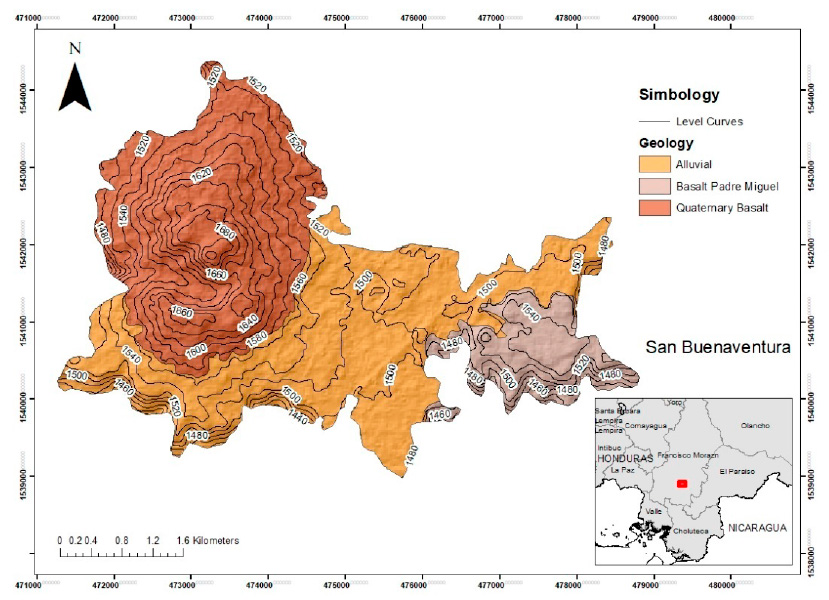
Figure 3: Geological map of the study area.
The proposed lithological column is as follows:
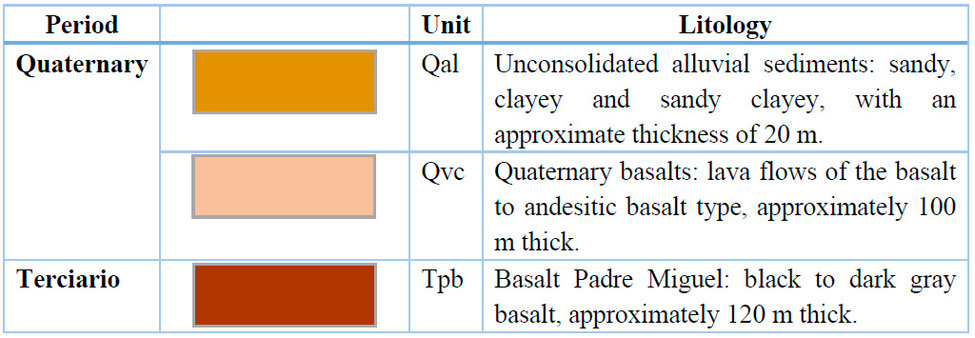
Basalt Padre Miguel: black to dark gray basalt, approximately 120 m thick.
Table 2: Lithological column of the area.
Therefore, the hydrogeology of the place is primarily conditioned by the area's geology, with two types of aquifers: fractured and porous (see Figure 7). The fractured aquifer is dominated by the geological structures present, the basalts found as a product of lava flows, generating outcrops of igneous rocks in some places, and this set of structures is called a fractured aquifer. Due to its high degree of fracturing, this type of aquifer suggests high permeabilities, which could indicate that it is a potential groundwater recharge zone conditioned by other elements such as land use, slope, and soil type4.
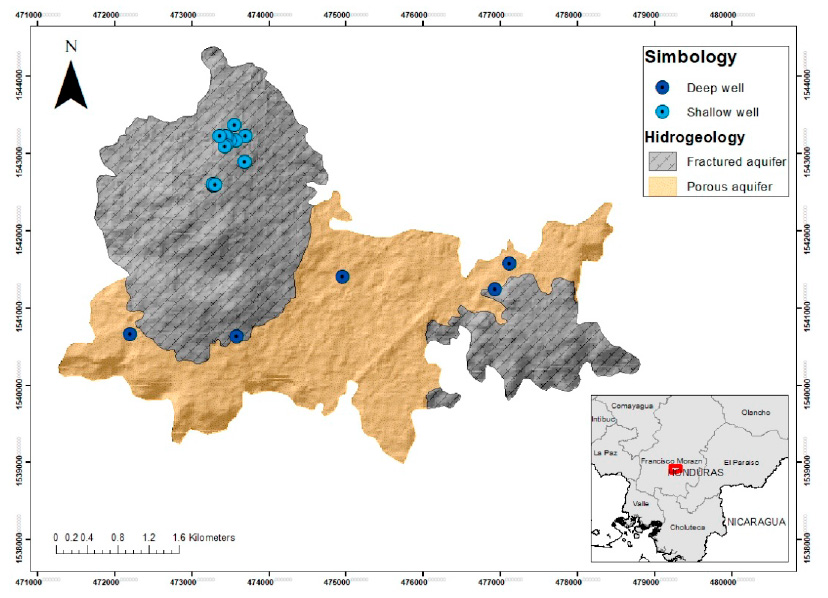
Figure 4: Hydrogeological map of the area under study and distribution of water sources identified and analyzed.
According to Simmons (1969)8, the study area features valley soils, characterized as alluvial soils that cover much of the country's surface and are suitable for intensive cultivation. These are mainly found in valley and terrace elements.
In line with the morphological and geological description, the study area is suggested to be a basaltic dome structure that has undergone erosion processes to form the terraces. Therefore, the present hydrography is of ephemeral drains that feed water bodies around the lower parts, mainly Qda. El Trapiche, Río Ojojona, Qda. El Sauce, Qda. Agua Fría, and Qda. Sicacatare, part of the surface water sub-basins Verdugo, Grande, and Texiguat, belong to the Choluteca River Basin.9.
Due to its great height, Cerro de Hula's primary water supply source is groundwater. This area has recently become an area of importance for the capital of Honduras since a large percentage of its population commutes to the city of Tegucigalpa for work10. Approximately 90% of the population of the municipality of Santa Ana is employed by companies that engage in different economic activities in Tegucigalpa11. Moreover, there are opportunities to obtain housing in new developments at a lower cost 12, supplied mainly by groundwater sources. Therefore, it becomes essential to conduct studies of the area's underground water resources, which can serve as management tools for underground water resources to stop or reverse these processes of groundwater depletion.
Among the main findings is identifying 21 groundwater supply sources in the area, of which 8 were surveyed in a study of the Adaptation Fund Project in 2014, and the remaining 13 points have been analyzed during this research. Out of the total wells, 5 are deep wells exceeding 150 m in depth, and 16 are shallow wells whose depths do not exceed 15 m. From these points, it was possible to measure the water table levels in April 2022, from which the isophreatic curves of the water in the study area have been constructed.
In line with the morphological and geological description, the study area is suggested to be a basaltic dome structure that has undergone erosion processes to form the terraces. Therefore, the present hydrography is of ephemeral drains that feed water bodies around the lower parts, mainly Qda. El Trapiche, Río Ojojona, Qda. El Sauce, Qda. Agua Fría, and Qda. Sicacatare, part of the surface water sub-basins Verdugo, Grande, and Texiguat, belong to the Choluteca River Basin.9.
Due to its great height, Cerro de Hula's primary water supply source is groundwater. This area has recently become an area of importance for the capital of Honduras since a large percentage of its population commutes to the city of Tegucigalpa for work10. Approximately 90% of the population of the municipality of Santa Ana is employed by companies that engage in different economic activities in Tegucigalpa11. Moreover, there are opportunities to obtain housing in new developments at a lower cost 12, supplied mainly by groundwater sources. Therefore, it becomes essential to conduct studies of the area's underground water resources, which can serve as management tools for underground water resources to stop or reverse these processes of groundwater depletion.
Among the main findings is identifying 21 groundwater supply sources in the area, of which 8 were surveyed in a study of the Adaptation Fund Project in 2014, and the remaining 13 points have been analyzed during this research. Out of the total wells, 5 are deep wells exceeding 150 m in depth, and 16 are shallow wells whose depths do not exceed 15 m. From these points, it was possible to measure the water table levels in April 2022, from which the isophreatic curves of the water in the study area have been constructed.
MATERIALS AND METHODS
The methodology used has been, first, data collection in the field. For this, field trips were carried out in April 2022 to update the healthy inventory in the area, where data collection forms were created and completed together with the local population and representatives of the entities managing the registered water source. This form collects the following aspects: general data, georeferencing of the source, data from the underground source, and physical data of the well. The physical information of the well includes depth, diameter, extraction pump, extraction flow rate (when it could be measured), and groundwater level, the data of which was the main one used to achieve the study's objective. All this information was recorded and adjusted in Excel for subsequent analysis.
For the construction of the isophreatic curves, the measured values for all the obtained points, whether from shallow or deep wells, were taken, understanding from its geology that there is a layer of fractured basalt with a depth exceeding 100m. This information created a grid of points with the spatial location and one of its properties, the measured water table level. With this information, the interpolation was carried out using the Kriging method, defined as a method for geostatistical analysis of data variation. This means that it analyzes the behavior of data in space by studying variograms13, 14.
This method has been applied in mining, geology, and hydrology, as it is a flexible spatial interpolation method. For example, one practical application is for the design of sampling networks, as Kriging is a method that can be used for data analysis in geohydrology15, 16, 17, 18.
During the geostatistical analysis, the geostatistical analyst tool available in the ArcGIS software was used19, 20. With this tool, an initial exploratory analysis was first performed, in which it was possible to visualize how the data are distributed, spatial trends, and outlier values. Subsequently, a random sample of the data was taken to generate the interpolation model, and another sample was used to validate this model. Next, the interpolation model was made using the Kriging method with the generated random sample. Finally, this generated model was validated with the data that were not included in the previously mentioned random sample, meeting the statistical quality standards and which best fit the behavior of the data. Once the interpolation model was created, the isophreatic curves were generated every 5 meters.
The materials and equipment used for this update, verification, and well census were GPS and Solinst 101 metric probes.21, plastic bucket, tape measure, stopwatch, camera, clipboard, field forms, and pencils. Excel and ArcGIS software were used for the analysis.
RESULTS
Among the main results is the census of new groundwater sources in the study area, of which 13 of 21 were analyzed for constructing the isophreatic curves. Of the total number of water wells used for the analysis, 5 belong to deep wells, and the rest belong to shallow wells (see Table 3).
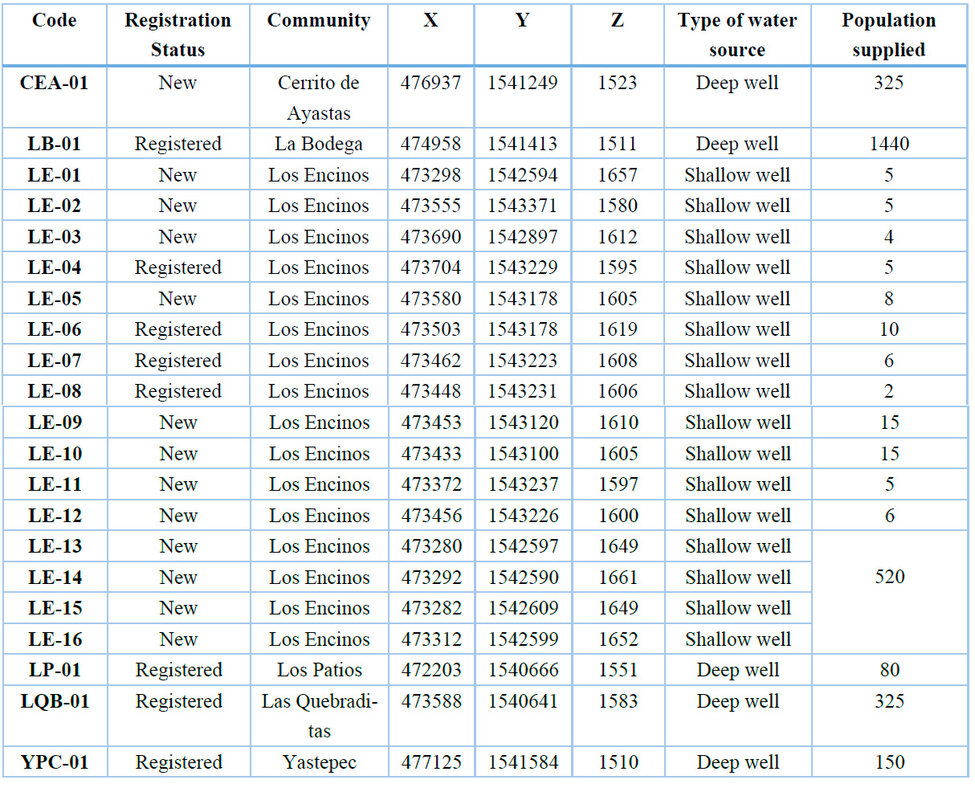
Table 3: Data from groundwater wells analyzed.
The depths of the wells under study, for the case of shallow wells, do not exceed 15 m, while deep wells range from 70 m to 153 m (see Figure 5).
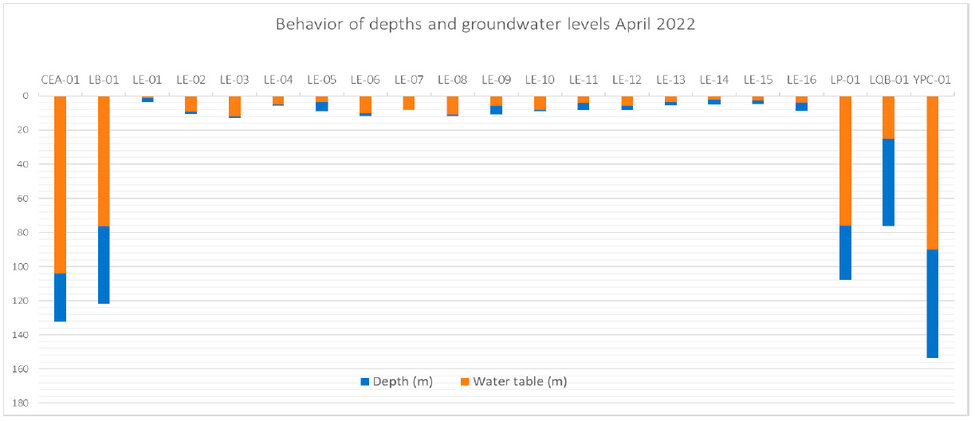
Figure 5: Graph of the behavior of the depths and groundwater levels of the wells under study.
It is essential to highlight that the population supplied by these wells is around 2900 people, which are distributed, as can be seen in Figure 6 and Table 3.
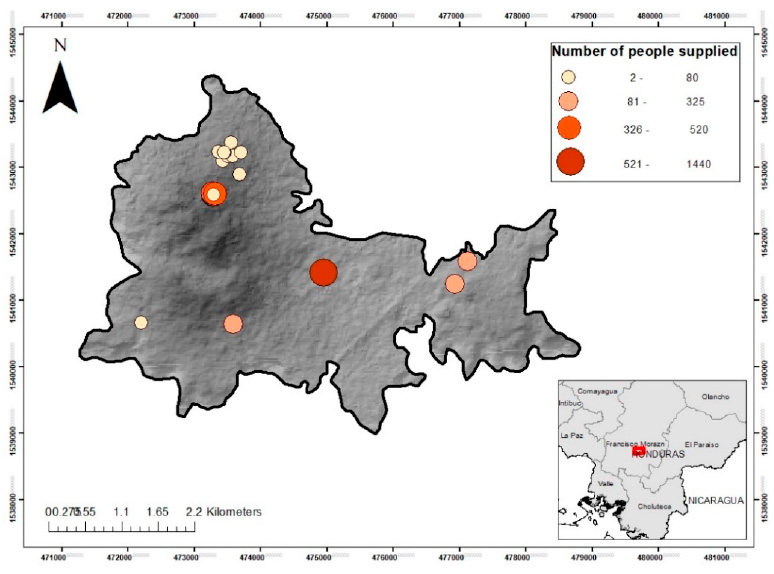
Figure 6: Population-supplied map.
Upon analyzing groundwater wells, the isophreatic curves were constructed. These curves range from the 5m contour located at the highest point of Cerro de Hula, situated to the west of the study area, and the lowest curve presents at over 100m, found in the deepest part of the well belonging to the community of Cerrito de Ayasta on the eastern side of the study area. (see Figure 7).
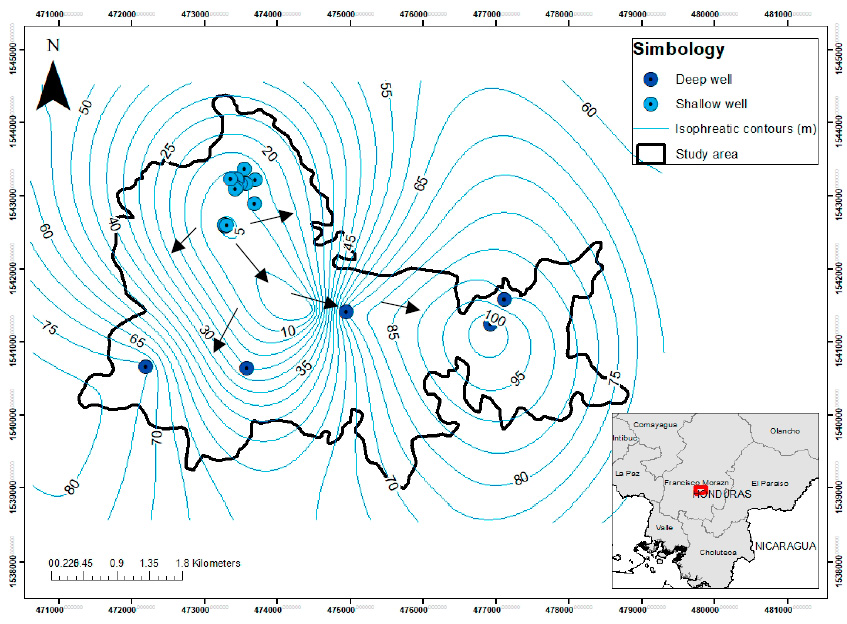
Figure 7: Isophreatic curves map of the study area.
DISCUSSION
The analysis of the isophreatic curves provides a preliminary view of the behavior of the underground flow22 in the area, which is dominated by its topography, as it is an area with a basalt dome structure at the highest part of Cerro de Hula 23, that over time has undergone erosion, which is why a shallow porous hydrogeological medium is located in the center of the area (see Figures 4 and 7)
This isophreatic behavior observed in the curves of Figure 7 shows that they have a radial flow24, 25 from the highest point of Cerro de Hula with curves ranging from 5 m deep at the water table level in the western part of the area and moving downwards to the 100 m curves in the eastern region, corresponding to the well of the communities of Cerrito de Ayasta.
This radial behavior converges in the central part of the study area, from the 10 m contour to the 100 m water depth contour, potentially representing a groundwater discharge behavior. In contrast, from the highest part, the 5 m contour to the south shows a potential recharge zone26.
Analyzing the isophreatic curves is a management tool for underground water resources in the study area, as it preliminarily shows us how the water moves there. This sets a baseline for future initiatives around groundwater study in the region and the country.
This study is just the beginning, mainly in building conceptual and numerical models whose elements aim to describe groundwater27. Understanding that a groundwater flow model becomes a fundamental tool to help understand how the system works and what volumes of the mass balance components are available to manage the underground water resource28 properly.
This isophreatic behavior observed in the curves of Figure 7 shows that they have a radial flow24, 25 from the highest point of Cerro de Hula with curves ranging from 5 m deep at the water table level in the western part of the area and moving downwards to the 100 m curves in the eastern region, corresponding to the well of the communities of Cerrito de Ayasta.
This radial behavior converges in the central part of the study area, from the 10 m contour to the 100 m water depth contour, potentially representing a groundwater discharge behavior. In contrast, from the highest part, the 5 m contour to the south shows a potential recharge zone26.
Analyzing the isophreatic curves is a management tool for underground water resources in the study area, as it preliminarily shows us how the water moves there. This sets a baseline for future initiatives around groundwater study in the region and the country.
This study is just the beginning, mainly in building conceptual and numerical models whose elements aim to describe groundwater27. Understanding that a groundwater flow model becomes a fundamental tool to help understand how the system works and what volumes of the mass balance components are available to manage the underground water resource28 properly.
CONCLUSIONS
Within the study area, 21 underground sources were identified, of which 13 were surveyed during the research, and 8 sources had their information updated but had already been identified in previous studies. Of the total water wells used for this study, 5 are deep wells, and 16 are shallow wells, with depths ranging between 70 m to 153 m and 15 m, respectively.
The obtained isophreatic behavior shows a divergent radial flow from the highest part to the 10 m curve, representing a recharge zone in the study area. Also, a divergent flow is shown between the 15 m and 85 m curves, thus being a potential discharge area for groundwater.
The obtained isophreatic curves are a preliminary water management tool to understand the behavior of the underground flow in the study area, as it is essential for supplying approximately 2900 people.
Author Contributions: Research, analysis, and original writing, Kelly Almendares-Rivera; Review and supervision, Tania Peña-Paz.
Funding: This research received no external funding.
Acknowledgments: Special thanks to the Coordination of the Master's Degree in Water Resources with a focus on Hydrogeology at the Universidad Nacional Autónoma de Honduras for their support in providing equipment for field data collection, which belongs to the Honduran Institute of Earth Sciences (IHCIT in Spanish) of UNAH. Also, we acknowledge the support from the Project of the Adaptation Fund to Climate Change, known as "Ecosystem-Based Adaptation in the Central Forest Corridor of Tegucigalpa," carried out by the Secretariat of Natural Resources and Environment (SERNA in Spanish) and the United Nations Development Programme (UNDP), as this project funded the preliminary information. Additionally, we extend our gratitude to Dr.-Ing. Carlos R. Guevara from Bundesanstalt für Geowissenschaften und Rohstoffe (the Federal Institute for Geosciences and Natural Resources (BGR)) in Hanover, Germany, for his thematic expertise and Research translated by Andrea José Rosales Tamashiro.
Conflicts of Interest: The authors declare no conflict of interest.
REFERENCES
1. INE. Instituto Nacional de Estadistica Honduras . Obtenido de INE: http://181.115.7.199/binhnd/RpWebEngine.exe/Portal?BASE=MUNDEP08&lang=ESP (2022).
2. ICF. Geoportal del Sector Forestal de Honduras. Obtenido de http://www.geoportal.icf.gob.hn/geoportal/main (2022).
3. IHCIT-UNAH. Evaluación de los Recursos Hídricos en su Régimen Natural. Tegucigalpa. (2014).
4. Ruiz, M.. Geología del área de influencia de los municipios de: Santa Ana, Ojojona y San Buenaventura. UNAH, Instituto Hondureño de Ciencias de la Tierra, Tegucigalpa. (2015).
5. Harwood, R. Geology of Ojojona Quadrangle. Instituto Geográfico Nacional y Dirección General de Minas e Hidrocarburos, Tegucigalpa, Honduras. (1991).
6. Anderson, M.. Geology of Lepaterique Quadrangle. Instituto Cartografico Nacional, Tegucigalpa, Honduras. (1985).
7. Rogers, R. O.. Geología del Cuadrangulo de Tegucigalpa, Francisco Morazán. Instituto Cartográfico Nacional, Tegucigalpa, Honduras. (1993).
8. Simmons, C. S.. Los Suelos de Honduras. Organizacion de las Naciones Unidas para la Agricultura y la Alimentación (FAO), Roma. (1969).
9. SINIT. Sistema Nacional de Información Territorial de Honduras. Obtenido de http://www.sinit.hn/ (2022).
10. Cruz, V. H., Galindo, K., Vásquez, C., & Edwar.. Plan de Desarrollo Municipal - Municipio de Santa Ana Francisco Morazán. Municipalidad de Santa Ana, Unidad Técnica Municipal, Santa Ana, Francisco Morazán. (2020). Obtenido de https://www.sgjd.gob.hn/biblioteca-virtual/docspdm/pdm-certificados/fco-morazan-pdm-certificados/1207-pdm-santa-ana-francisco-morazan/file
11. Municipalidad de Santa Ana.. Informe Levantamiento Línea Base Municipio de Santa Ana, Francisco Morazán. Santa Ana, Francisco Morazán. (2018). Obtenido de https://www.sgjd.gob.hn/biblioteca-virtual/docspdm/linea-base/08-francisco-morazan/1475-linea-base-santa-ana-francisco-morazan/file
12. Heraldo, E.. La zona sur de la capital se perfila como el nuevo polo de desarrollo. El Heraldo. Obtenido de https://www.elheraldo.hn/tegucigalpa/zona-sur-tegucigalpa-desarrollo-honduras-LXEH1465097#image-1. (2021).
13. Villatoro, M., Henríquez, C., & Sancho, F.. Comparación de los interpoladores idw y kriging en la variación espacial de ph, ca, cice y p del suelo. Agronomía Costarricense, 2008. 32(1), 95-105. Obtenido de https://revistas.ucr.ac.cr/index.php/agrocost/article/view/6773
14. Zucarelli, A., Paris, M., & Macor, J.. Utilización de kriging para la elaboración de curvas isohietas de precipitación mensual en la Provincia de Santa Fe, Argentina. Universidad Nacional del Litoral, Facultad de Ingeniería en Ciencias Hídricas, Santa Fé, Argentina. (2014). Obtenido de http://www.tvdigitalargen.ina.gov.ar/ifrh-2014/Eje3/3.39.pdf
15. Hughes, J., & Lettenmaier, D.. Data Requirements for Kriging: Estimation and Network Design. Water Resources Research, 1981. 17(6), 1641-1650. doi: https://doi.org/10.1029/WR017i006p01641
16. Rouhani, S., & Hall, T. J.. Geostatistical Schemes for Groundwater Sampling. Journal of Hydrology, 1988. 103, 85-102. doi: https://doi.org/10.1016/0022-1694(88)90007-8
17. Rouhani, S.. Geostatistics in Water Resources. Georgia Water Resources Conference. Georgia. (1989). Obtenido de https://repository.gatech.edu/server/api/core/bitstreams/e66fc3cd-6b12-4e20-af07-69a98da79499/content
18. Kitanidis, P. K.. Introduction to Geostatistics: : Applications in Hydrogeology. Stanford, California, EUA. 1997. Obtenido de https://books.google.es/books?hl=es&lr=&id=ZvoibTTS9QwC&oi=fnd&pg=PR19&dq=Introduction+to+Geostatistics+P.+K.+KITANIDIS&ots=q7BwBHFQqV&sig=9Fy-vSPhmDW_-OHUMROL40RMyNE#v=onepage&q=Introduction%20to%20Geostatistics%20P.%20K.%20KITANIDIS&f=false
19. Mejía Rivera, O., Betancur Vargas, T., & Londoño Ciro, L.. Aplicación de técnicas geoestadisticas en la hidrogeología del bajo Cauca Antioqueño. SciELO Analytics, 2007. 74(152), 137-149. Obtenido de http://www.scielo.org.co/scielo.php?script=sci_arttext&pid=S0012-73532007000200012
20. Gaspari, F. J., & Delgado, M. I.. Caracterización morfométrica geoespacial. Estudio de caso: Arroyo Belisario, Argentina. Tecnociencia Chichuahua, 2010. 4(3), 154-163. doi: https://doi.org/10.54167/tch.v4i3.711
21. Solinst, C.. Solinst Canada Ltd. Obtenido de Solinst Canada Ltd: https://www.solinst.com/espanol/productos/instrumentos-de-medicion-de-nivel/101-medidor-de-niveles-de-agua/ficha-tecnica/?utm_source=GA-&utm_medium=Search-&utm_campaign=101-GA-101-search-sa&utm_term=LM-SA-&utm_content=responsivetextad-spanish1&gad=1&gclid. (2023).
22. Barrera-de-Calderón, M., Garfias, J., Martel, R., & Salas-García, J.. Controles geológicos en el flujo de agua subterránea y distribución de volúmenes de extracción asociados a una estructura volcánica compleja. Boletín de la Sociedad Geológica Mexicana, 2021. 73(1), A170820 doi: https://doi.org/10.18268/BSGM2021v73n1a170820
23. Ruffo, A. G., Albouy, R., Giorgi, J., & Bastianelli, N.. El agua subterránea para abastecimiento humano en las dunas costeras del suroeste bonaerense. I Jornadas del agua en el Sudoeste Bonaerense, (págs. 293-296). Bahía Blanca, Argentina. (2019). Obtenido de https://www.researchgate.net/publication/338047277_El_agua_subterranea_para_abastecimiento_humano_en_las_dunas_costeras_del_suroeste_bonaerense
24. Gastmans, D., Veroslavsky, G., Kiang Chang, H., Caetano-Chang, M. R., & Nogueira Pressinotti, M. M.. Modelo hidrogeológico conceptual del Sistema Acuífero Guaraní (SAG): una herramienta para la gestión. Boletín Geológico y Minero, 2012. 123(3), 249-265. Obtenido de https://www.igme.es/boletin/2012/123_3/8_ARTICULO%204.pdf
25. Barrera de Calderón, M. L., Garfias, J., Martel, R., & Salas Garcia, J.. Influencia potencial de las fallas en el flujo de agua subterránea de un acuífero volcánico conformado por materiales porosos y fracturados. (T. y. agua, Ed.) Repositorio Institucional Universidad Autónoma del Estado de México. (2020). Obtenido de http://ri.uaemex.mx/handle/20.500.11799/106013
26. Auge, M.. Hydrogeology of Plains. Buenos Aires, Argentina: Springer. (2016). Obtenido de https://www.bfa.fcnym.unlp.edu.ar/id/42552
27. Enemark, T., Peeters, L., Mallants, D., & Batelaan, O.. Hydrogeological conceptual model building and testing: A review. Journal of Hydrology, 2018. 569, 310-329. https://doi.org/10.1016/j.jhydrol.2018.12.007
28. Mira, A., Vives, L., Rodríguez, L., & Veroslavsky, G.. Modelo hidrogeológico conceptual y numérico del Sistema Acuífero Guaraní (Argentina, Brasil, Paraguay y Uruguay). Sociedad Geológica de España-Geogaceta, 2018. 64, 67-70. Obtenido de https://sge.usal.es/archivos/geogacetas/geo64/geo64_17.pdf
Received: October 9th 2023/ Accepted: January 15th 2024 / Published:15 February 2024
Citation: Almendares-Rivera, K.; Peña-Paz. Isophreatic curves of groundwater wells in the upper zone of Cerro de Hula, Santa Ana, Francisco Morazán. Bionatura Journal 2024; 1 (1) 39. http://dx.doi.org/10.21931/BJ/2024.01.01.39
Additional information Correspondence should be addressed to [email protected]
Peer review information. Bionatura Journal thanks anonymous reviewer(s) for their contribution to the peer review of this work using https://reviewerlocator.webofscience.com/
All articles published by Bionatura Journal are made freely and permanently accessible online immediately upon publication, without subscription charges or registration barriers.
Publisher's Note: Bionatura Journal stays neutral concerning jurisdictional claims in published maps and institutional affiliations.
Copyright: © 2024 by the authors. They were submitted for possible open-access publication under the terms and conditions of the Creative Commons Attribution (CC BY) license (https://creativecommons.org/licenses/by/4.0/).
